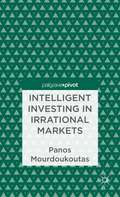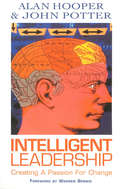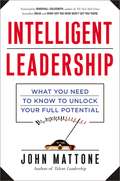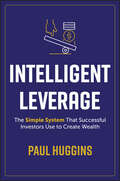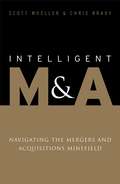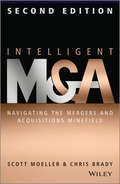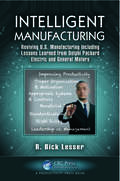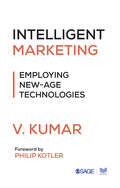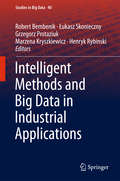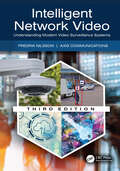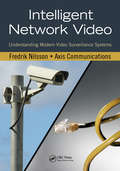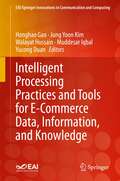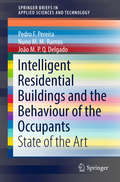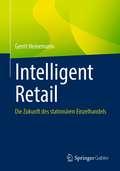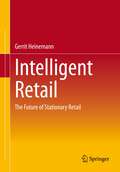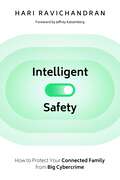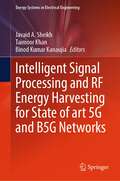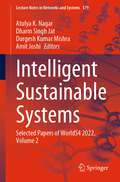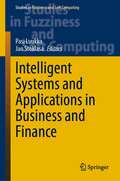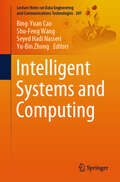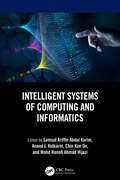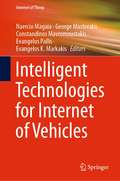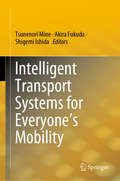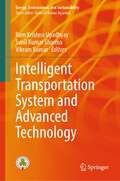- Table View
- List View
Intelligent Investing in Irrational Markets
by Panos MourdoukoutasAs a game of economics, investing involves the basic principles of economics that help investors identify financial goals and constraints, and come up with the right asset and portfolio allocation. Mourdoukoutas outlines the rules for investing in irrational markets successfully.
Intelligent Leadership
by John Potter Alan HooperThe need for high-quality leadership in all areas of business and organisational activity has never been greater. A myriad of interlinked factors mean that styles of leadership that were appropriate in the past are now no longer working. These factors include new technologies, more questioning attitudes to authority, the arrival of the "virtual organization" with its network of contributors, and the unprecedentedly high expectations of customers and employees. In Intelligent Leadership, Alan Hooper and John Potter look at how changes affect people in businesses and organisations, using specific case studies of individuals. They propose practical ways for leaders to provide effective leadership in a quickly changing and confusing work environment. The focus is on winning hearts and minds, on leadership as an emotional and psychological commitment to the people being led, and on the idea of emotional intelligence.
Intelligent Leadership: What You Need to Know to Unlock Your Full Potential
by John MattoneIn today's business environment, leaders at all levels are facing enormous challenges when it comes to achieving and sustaining breakthrough operating results. Globalization, economic change, more stringent regulation, and tougher governance make realizing shareholder value increasingly difficult. Leadership Intelligence is written for leaders who want to become more effective, strategic, operationally focused, and balanced. It is for leaders who are striving to take control of their destiny and become the best they can be. In this groundbreaking book, leadership coach John Mattone - recently named to the "guru radar" by the prestigious Thinkers50 - taps into his years of experience working with high-achieving professionals to give readers a roadmap for developing and mastering their executive maturity. Supplying three unique tools - the Wheel of Leadership Success, Map of Leadership Maturity, and the Leadership Enneagram - the book helps readers calibrate their abilities so they can simultaneously focus on their strengths and address their weaknesses. The goal is to improve key tactical competencies (such as critical andstrategic thinking, decision-making, talent and team leadership, and communication) and integrate them with equally important inner traits like values, character, and beliefs in order to achieve their leadership potential. Featuring best practices, authoritative research, practical assessments, and enlightening examples of both good and bad leadership, this book equips readers with the knowledge, skills, and passion theyneed to become the leaders they were meant to be.
Intelligent Leverage: The Simple System That Successful Investors Use to Create Wealth
by Paul HugginsDiversify your investments, generate greater returns, and leverage your assets for a definite and brighter financial future When it comes to growing your wealth, there are clear systems and smart strategies you can leverage to ensure your investments will successfully outperform in the long term. In Intelligent Leverage, you’ll discover how successful investors grow their wealth and ensure their financial security — through everyday investments that can generate millions. With these strategies, you too can take control of your assets and be empowered in where you put your money. Veteran investment manager Paul Huggins shows how to leverage every opportunity that comes your way. With his guidance, you’ll rethink your current way of planning and investing so that you can feel certain about your financial future. You’ll learn how to build an asset base and the right networks, creating an ecosystem that will catapult you into the next stratosphere of financial independence. Understand how economic forces and environment impact your financial goals Learn how to supplement your superannuation with time-tested assets like property and shares, as well as more advanced leveraging instruments Hone your investor mindset: leverage your time and energy, assess risk versus returns, and learn how to do more with less Get better strategies to manage your assets, from protecting what you have through insurances and hedging, to minimising your tax bill Set goals and establish a step-by-step plan to monitor progress and growth in real time. Intelligent Leverage is a handbook for financial success. Its straightforward, logical approach to savvy investing will show you how to revolutionise your lifestyle and better plan for a future that is financially free.
Intelligent M & A
by Chris Brady Scott MoellerAlmost 70% of mergers fail, yet deals are essential for growing world-class companies. Therefore they must use all the tools and techniques at their disposal to improve their chances of success. Applying the techniques advocated in this book can help managers beat the odds - and employees themselves - to have an impact on whether a deal will be successful both for the company and for themselves.This book looks at the process of a merger or acquisition and pinpoints the areas where business intelligence can raise the odds of success in each phase of the deal. Using techniques developed by governmental intelligence services and a wide range of recent case studies, quotations and anecdotes, the expert authors from the renowned Cass Business School show how to build success into any M&A situation.The first edition of Intelligent M&A was written in 2006 and published in 2007. This preceded the peak year (2007) of the last merger wave, including the excesses in a number of industries and deals (e.g., financial services with RBS' dramatically failed acquisition of ABN AMRO as a key example), and the global economic downturn that led to a completely new way of operating for many industries and companies.Therefore, there is a need to update the book to incorporate not just more relevant and up-to-date case studies of deals but to show the 'new' way of operating in a post-Lehman environment. Chapters will be comprehensively re-written and populated with new and relevant case studies.
Intelligent M & A: Navigating the Mergers and Acquisitions Minefield
by Chris Brady Scott MoellerAlmost 70% of mergers fail, yet deals are essential for growing world-class companies. Therefore they must use all the tools and techniques at their disposal to improve their chances of success. Applying the techniques advocated in this book can help managers beat the odds - and employees themselves - to have an impact on whether a deal will be successful both for the company and for themselves. This book looks at the process of a merger or acquisition and pinpoints the areas where business intelligence can raise the odds of success in each phase of the deal. Using techniques developed by governmental intelligence services and a wide range of recent case studies, quotations and anecdotes, the expert authors from the renowned Cass Business School show how to build success into any M&A situation. The first edition of Intelligent M&A was written in 2006 and published in 2007. This preceded the peak year (2007) of the last merger wave, including the excesses in a number of industries and deals (e.g., financial services with RBS’ dramatically failed acquisition of ABN AMRO as a key example), and the global economic downturn that led to a completely new way of operating for many industries and companies. Therefore, there is a need to update the book to incorporate not just more relevant and up-to-date case studies of deals but to show the ‘new’ way of operating in a post-Lehman environment. Chapters will be comprehensively re-written and populated with new and relevant case studies.
Intelligent Manufacturing: Reviving U.S. Manufacturing Including Lessons Learned from Delphi Packard Electric and General Motors
by R. Bick LesserIn 1791, Treasury Secretary Alexander Hamilton wrote that "not only the wealth, but the independence and security of a country, appear to be materially connected with the prosperity of manufacturers." Centuries later, U.S. manufacturing jobs continue to be outsourced at an all-too-rapid pace. Examining the current U.S. manufacturing environment, in
Intelligent Marketing: Employing New-Age Technologies
by V. KumarDo you have specific tactics to survive this era of digital transformation? How can a firm extract powerful insights from responding to and implementing new-age technologies? Some companies adapt. Others miss the boat. Knowledge of what technology to employ, how to employ it, when and why it should be employed is a must in this era. Intelligent Marketing emphasizes organizing resources, developing capabilities and designing strategies for deploying new-age technologies to ensure a healthy financial outcome for all the key stakeholders, and a better quality of life for the society and community.
Intelligent Methods and Big Data in Industrial Applications (Studies in Big Data #40)
by Marzena Kryszkiewicz Robert Bembenik Łukasz Skonieczny Henryk Rybinski Grzegorz ProtaziukThe inspiration for this book came from the Industrial Session of the ISMIS 2017 Conference in Warsaw. It covers numerous applications of intelligent technologies in various branches of the industry. Intelligent computational methods and big data foster innovation and enable the industry to overcome technological limitations and explore the new frontiers. Therefore it is necessary for scientists and practitioners to cooperate and inspire each other, and use the latest research findings to create new designs and products. As such, the contributions cover solutions to the problems experienced by practitioners in the areas of artificial intelligence, complex systems, data mining, medical applications and bioinformatics, as well as multimedia- and text processing. Further, the book shows new directions for cooperation between science and industry and facilitates efficient transfer of knowledge in the area of intelligent information systems.
Intelligent Network Video: Understanding Modern Video Surveillance Systems
by Fredrik Nilsson Communications AxisThe third edition traces the trajectory of video surveillance technology from its roots to its current state and into its potential future role in security and beyond. For the reader, it is an opportunity to explore what the latest technology has to offer, as well as to gain some insight into the direction that surveillance will take us in the years ahead. The revised edition of Intelligent Network Video is more comprehensive in every area than the first and second editions, printed in over 25,000 copies. There is also a new chapter on cybersecurity, as well as thoroughly revised chapters on cloud and analytics. The book takes the reader on a tour through the building blocks of intelligent network video – from imaging to network cameras and video encoders, through the IT technologies of network and storage and into video management, analytics, and system design.
Intelligent Network Video: Understanding Modern Video Surveillance Systems
by Fredrik Nilsson Communications AxisThe third edition traces the trajectory of video surveillance technology from its roots to its current state and into its potential future role in security and beyond. For the reader, it is an opportunity to explore what the latest technology has to offer, as well as to gain some insight into the direction that surveillance will take us in the years ahead.The revised edition of Intelligent Network Video is more comprehensive in every area than the first and second editions, printed in over 25,000 copies. There is also a new chapter on cybersecurity, as well as thoroughly revised chapters on cloud and analytics. The book takes the reader on a tour through the building blocks of intelligent network video – from imaging to network cameras and video encoders, through the IT technologies of network and storage and into video management, analytics, and system design.
Intelligent Network Video: Understanding Modern Video Surveillance Systems, Second Edition
by Fredrik Nilsson Communications AxisContinuing in the tradition of the bestselling first edition, this book examines networked surveillance video solutions. It provides the latest details on industry hardware, software, and networking capabilities of the latest cameras and DVRs. It addresses in full detail updated specifications on MPEG-4 and other digital video formats, resolution advantages of analog v. digital, intelligent video capabilities, frame rate control, and indoor/outdoor installations factors. New chapters include cloud computing, standards, and thermal cameras.
Intelligent Processing Practices and Tools for E-Commerce Data, Information, and Knowledge (EAI/Springer Innovations in Communication and Computing)
by Honghao Gao Muddesar Iqbal Jung Yoon Kim Walayat Hussain Yucong DuanThis book discusses recent research and applications about intelligent processing practices and tools for e-commerce data, information and knowledge. The authors first explain how advances in intelligent processing of data, information and knowledge that has wildly been used in e-commerce applications. They then show how this brings new opportunities and challenges for processing e-commerce data, information and knowledge. The book, made up of contributions from both academia and industry, aims to present advances in artificial intelligence to collect, process, and mining Data, information and knowledge, such as new algorithms and techniques in the field, foundational theory and systems, as well as practical e-commerce applications. Some of the topics discussed include AI for e-commerce, such as machine learning, deep learning; personalized service recommendation to e-commerce; modeling, description, and verification for data, information and knowledge; and task scheduling and performance optimization for large-scale concurrency.
Intelligent Residential Buildings and the Behaviour of the Occupants: State of the Art (SpringerBriefs in Applied Sciences and Technology)
by Nuno M.M. Ramos João M.P.Q. Delgado Pedro F. PereiraThis book presents the state of the art of two areas: intelligent residential buildings and the behaviour of their occupants. These areas need to be treated together in order to develop new concepts for buildings, which are more efficient, more comfortable and more healthy. The concept of intelligent building is associated with the creation of a management system that takes into account the requirements of the occupants in terms of thermal comfort and their daily activities, maintaining good indoor air quality and minimizing energy consumption. In commercial or office buildings, these systems are already at an intermediate stage of implementation. However, in the residential sector they have yet to be significantly implemented. In mild climates, where the interactions of the occupants with the building mechanisms are the primary way to ensure adequate comfort and ventilation, the importance of occupant behaviour studies and their incorporation in the algorithms of the intelligent buildings becomes even more crucial. This book offers new concepts on how to bring these aspects together.
Intelligent Retail: Die Zukunft des stationären Einzelhandels
by Gerrit HeinemannDieses Buch zeigt dem stationären Einzelhandel einen Weg auf, wie er sich nach Corona neu erfinden kann, um gegen die starke Konkurrenz des Online-Handels bestehen zu können. Im Zentrum stehen die zentralen Themen, die den Handel der Zukunft prägen. So muss vor allem der stationäre Einzelhandel heute mit intelligenten Systemen datenbasiert arbeiten und Methoden übernehmen oder sogar übertreffen, die die großen Online-Marktplätze schon sehr lange und erfolgreich einsetzen. Diesbezüglich spielt auch künstliche Intelligenz im Einzelhandel eine große Rolle. Dabei geht es nicht bloß um Automatisierung und um die Übernahme von Tätigkeiten durch Roboter, sondern in eigentlich allen Handelsfunktionen auch darum, dass Instrumente und Maschinen in der Lage sind, selbst zu lernen und Schlüsse zu ziehen. Dieses wird immer schwieriger, denn unser Einkaufs- und Suchverhalten ändert sich fortwährend. Ein Kunde sollte deswegen im Geschäft intelligente Empfehlungen erhalten, die auch auf seinen bereits bekannten Interessen und Verhaltensmustern beruhen. Gerrit Heinemann zeigt, wie intelligentes Handeln den stationären Einzelhandel in den Innenstädten und in Shopping-Centern retten kann. Der Inhalt• Vom stationären Einzelhandel zum Intelligent Retail• Bedrohungen des stationären Einzelhandels• Basisvoraussetzungen und Erscheinungsformen des Intelligent Retail• Beispiele für intelligenten Einzelhandel der Zukunft• Risiken für Intelligent Retail
Intelligent Retail: The Future of Stationary Retail
by Gerrit HeinemannThis book shows stationary retail a way to reinvent itself after Corona, in order to be able to survive against the strong competition of online retail. The focus is on the central issues that will shape the retail of the future. For example, brick-and-mortar retail in particular must now work with intelligent systems based on data and adopt or even surpass methods that the large online marketplaces have been using successfully for a very long time. In this regard, artificial intelligence also plays a major role in retail. This is not just about automation and robots taking over tasks, but also about instruments and machines being able to learn and draw conclusions themselves in all retail functions. This is becoming increasingly difficult because our shopping and search behavior is constantly changing. Therefore, a customer should receive intelligent recommendations in the store, which are also based on his already known interests and behavior patterns. Gerrit Heinemann shows how intelligent action can save stationary retail in city centres and shopping centres.The content - From stationary Retail to intelligent Retail - Threats to the stationary retail trade - Basic requirements and manifestations of intelligent Retail - Examples of intelligent retail of the future - Risks for intelligent Retail
Intelligent Safety: How to Protect Your Connected Family from Big Cybercrime
by Hari RavichandranTurn the tables on cybercriminals. Keep your loved ones safe. We live much of our personal and professional lives online, but fraudsters and hackers have made the internet dangerous. Cyberattacks are the US&’s fastest growing crime: consumers lost more than $6.9 billion to fraud in 2021, up more than 50% from 2020; financial losses from online theft surpassed losses from home theft; 1 in 10 people become identity theft victims annually, including more than 1 million children. So how do we keep our kids, parents, colleagues, and selves safe against organized cybercriminals with their increasingly advanced tools?Intelligent Safety: How to Protect Your Connected Family from Big Cybercrime teaches how we can put our families&’ online safety on autopilot and regain our peace of mind. It provides families with the tools and knowledge they need to create a personalized, proactive defense against cybercriminals. From identifying the risks of your teen&’s secret online life to safeguarding your family finances to defending the vulnerabilities of your aging parents, Intelligent Safety is the last guide you&’ll need to beat cyber predators at their own game.
Intelligent Signal Processing and RF Energy Harvesting for State of art 5G and B5G Networks (Energy Systems in Electrical Engineering)
by Taimoor Khan Binod Kumar Kanaujia Javaid A. SheikhThe book covers all the emerging paradigms of machine learning and bio-inspired algorithms and their synergies with communication networks which may prove to a core 5G and 6G enablers. It consists of 11 chapters with varied fields. The book introduces the fundamentals of broadband wireless networks and issues related to energy efficiency and optimization. Also, it discusses the efficient bio-inspired algorithms and their utility in wireless networks for 5G, B5G, and IoT. Different fitness functions for different bio-inspired and other artificial intelligence algorithms are described in the book. More importantly it also introduces the concept, implementation, and technological challenges of efficient wireless energy harvesting methods. The book discusses different methodologies for efficient antenna designs. It also covers real-time applications on the Internet of Medical Things (IOMT). The book helps the readers to understand the subject and solve many real-time issues. It proves a ready reference to the researchers working in RF, artificial intelligence, machine learning, and communication networks.
Intelligent Sustainable Systems: Selected Papers Of Worlds4 2022 (Lecture Notes In Networks And Systems Series #579)
by Amit Joshi Durgesh Kumar Mishra Atulya K. Nagar Dharm Singh JatThis book provides insights of World Conference on Smart Trends in Systems, Security and Sustainability (WS4 2022) which is divided into different sections such as Smart IT Infrastructure for Sustainable Society; Smart Management Prospective for Sustainable Society; Smart Secure Systems for Next Generation Technologies; Smart Trends for Computational Graphics and Image Modeling; and Smart Trends for Biomedical and Health Informatics. The proceedings is presented in two volumes. The book is helpful for active researchers and practitioners in the field.
Intelligent Systems and Applications in Business and Finance (Studies in Fuzziness and Soft Computing #415)
by Pasi Luukka Jan StoklasaThis book presents a selection of current research results in the field of intelligent systems and draws attention to their practical applications and issues connected with the areas of decision-making, economics, business and finance. The nature of the contributions is interdisciplinary – combining psychological and behavioural aspects with the theory and practice of decision-support, design of intelligent systems and development of machine learning tools. The authors, among other topics, discuss the multi-expert evaluation with intangible criteria, suggest a redefinition of the standard multiple-criteria decision-making framework, propose novel methods for causal map analysis and new feature selection methods. The topics are selected to stress the potential of the up-to-date intelligent methods to deal with practical problems relevant in these areas and to provide inspiration for advanced students, researchers and practitioners in the respective fields.
Intelligent Systems and Computing (Lecture Notes on Data Engineering and Communications Technologies #207)
by Bing-Yuan Cao Yu-Bin Zhong Seyed Hadi Nasseri Shu-Feng WangThis book includes high quality research papers submitted at the 2022 “Four Session (ICFIE, ICORG, GDORS, CGHMORS) Celebration” Joint International Conference held on December 28, 2022 and the online meeting of the Fuzzy Information and Engineering Branch of the China Operations Research Society on September 17, 2022. It covers topics in the fields of certainty, stochastic uncertainty, and fuzzy uncertainty, including computer science and mathematics, operations research and control, artificial intelligence, information and engineering technology, barrier-free communication for people with disabilities, digital logistics and knowledge representation, medical applications, queuing theory and game theory, algorithms and optimization methods. The book is a valuable reference book for scholars, engineers, management professionals, and graduate, undergraduate, and vocational students interested in computer science, mathematics, and fuzzy mathematics and operations research, as well as their applications in information technology and engineering.
Intelligent Systems of Computing and Informatics
by Anand J. Kulkarni Chin Kim On Abdul Karim, Samsul Ariffin Hijazi, Mohd Hanafi AhmadSince 2011, the Fourth Industrial Revolution (IR4.0) has played a significant role in education, research, and industry. Data technologies have also evolved rapidly to cater to the rapidly growing size of the data as well as to enhance the security of the shared data through multiple resources and platforms.Intelligent Systems of Computing and Informatics aims to develop a new Intelligent Systems of Computing and Informatics (ISCI) to cater to the needs of industries in line with the United Nations’ Sustainable Development Goals (SDGs) of affordable and clean energy and sustainable cities and communities.Comprising 20 chapters by experts from all over the world, this book covers such topics as data technologies, machine learning, signal and image processing, software systems efficiency, computer networking, Internet of Things, and computational intelligence for real-life problems.Key Features: Develops a new system for computing and informatics Provides the state of the art of current research and studies in intelligence systems Written by experts in the field of computing and informatics This book is aimed at postgraduate students, researchers working in various research and development (R&D) agencies, and practitioners, as well as scientists that have an interest in ISCI.
Intelligent Technologies for Internet of Vehicles (Internet of Things)
by George Mastorakis Evangelos Pallis Naercio Magaia Constandinos Mavromoustakis Evangelos K. MarkakisThis book gathers recent research works in emerging Artificial Intelligence (AI) methods for the convergence of communication, caching, control, and computing resources in cloud-based Internet of Vehicles (IoV) infrastructures. In this context, the book's major subjects cover the analysis and the development of AI-powered mechanisms in future IoV applications and architectures. It addresses the major new technological developments in the field and reflects current research trends and industry needs. It comprises a good balance between theoretical and practical issues, covering case studies, experience and evaluation reports, and best practices in utilizing AI applications in IoV networks. It also provides technical/scientific information about various aspects of AI technologies, ranging from basic concepts to research-grade material, including future directions. This book is intended for researchers, practitioners, engineers, and scientists involved in designing and developing protocols and AI applications and services for IoV-related devices.
Intelligent Transport Systems for Everyone’s Mobility
by Tsunenori Mine Akira Fukuda Shigemi IshidaThis book presents the latest, most interesting research efforts regarding Intelligent Transport System (ITS) technologies, from theory to practice. The book’s main theme is “Mobility for everyone by ITS”; accordingly, it gathers a range of contributions on human-centered factors in the use or development of ITS technologies, infrastructures, and applications. Each of these contributions proposes a novel method for ITS and discusses the method on the basis of case studies conducted in the Asia-Pacific region.The book are roughly divided into four general categories: 1) Safe and Secure Society, 2) ITS-Based Smart Mobility, 3) Next-Generation Mobility, and 4) Infrastructure Technologies for Practical ITS. In these categories, several key topics are touched on with each other such as driver assistance and behavior analysis, traffic accident and congestion management, vehicle flow management at large events, automated or self-driving vehicles, V2X technologies, next-generation public transportation systems, and intelligent transportation systems made possible by big data analysis. In addition, important current and future ITS-related problems are discussed, taking into account many case studies that have been conducted in this regard.
Intelligent Transportation System and Advanced Technology (Energy, Environment, and Sustainability)
by Vikram Kumar Ram Krishna Upadhyay Sunil Kumar SharmaThis book explores the recent advancements in intelligent transportation sector. In today's rapidly evolving world, transportation plays a pivotal role in shaping our societies and economies. As the demands on our transportation systems continue to grow, there is an increasing need for innovative solutions to enhance efficiency, safety, and sustainability. This book provides a comprehensive and up-to-date exploration of the intersection between transportation and cutting-edge technology. It offers a thorough examination of the various facets of Intelligent Transportation Systems (ITS) and advanced technologies applied to the transportation sector. It analyzes the latest trends, technologies, and developments that are shaping the future of transportation, including AI, IoT, and smart infrastructure. It provides practical insights, case studies, and real-world examples to help transportation professionals and researchers understand how advanced technology can be applied to address transportation challenges. It discusses the policy and regulatory considerations surrounding the implementation of advanced transportation technologies and explores the potential future developments and advancements in the field, including the impact of emerging technologies.
